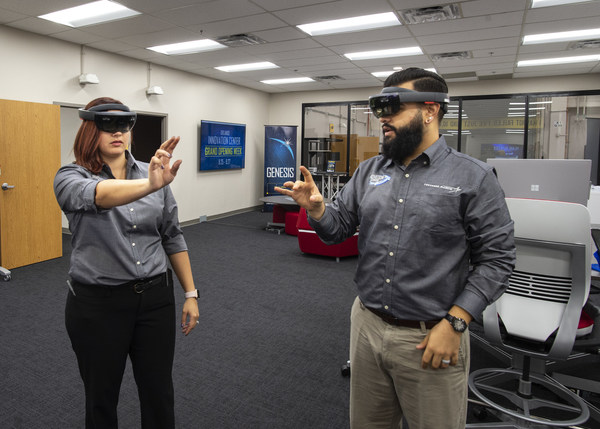ORLANDO, Fla., Sept. 25, 2018 /PRNewswire/ -- Necessity sparks invention at the Innovation Center, now open at Lockheed Martin's (NYSE: LMT) Missiles and Fire Control (MFC) facility in Orlando, Florida. In this 6,500-square-foot space, employees are empowered with the technology and tools to develop creative solutions to complex problems.
The company expects it to aid in the creation of new patents and the win of new multimillion-dollar contracts.

Lockheed Martin IC-Opening-Sept 2018
"Innovation is our 'day job' — it is core to who we are and everything we do," said Frank St. John, executive vice president at MFC. "This facility gives employees the means to bring ideas from our unlimited imaginations to life. The result of which will help us invent technologies to solve previously unsolvable problems."
Five specialized labs, a next-generation video conference capability and an interactive lobby serve more than 5,000 employees and counting amidst a hiring surge at the southwest Orlando facility. Virtual reality, robotics, computer-simulated environments, 3-D printing and more are available at workers' fingertips to encourage new ways of thinking and approaching business needs. The space will also host monthly hands-on demonstrations as well as live webcasts across the business.
This is the second of its kind at MFC. In less than a year's time, the Innovation Center in Dallas, Texas, has helped secure millions of dollars' worth of captured programs.
"The Innovation Center is a destination for our program teams to explore what's possible with the use of high technology," said Tom Mirek, vice president deputy of engineering and technology at MFC. "Like we already have in Dallas, we're going to recognize Orlando's Innovation Center for being a vital resource to the success of our company for years to come."
Orlando's Innovation Center is comprised of five unique labs:
- The Application Research Experimentation & Simulation (ARES) facility allows teams to use their own computing environment and applications to conduct events on a rapidly reconfigurable 12-screen hyperwall.
- The Genesis Lab is where ideas are born, and one can incubate and develop concepts in a creative, resourceful environment — 24 hours a day, seven days a week. Employees have access to augmented and virtual reality, small robotics, Arduino, Raspberry Pi, high-powered computing, and 3-D printers.
- The Iris Lab offers an indoor robotics test bay for safe and controlled training, experiments, and research.
- The Engineering Visualization Environment Lab and its animators take complex ideas and bring them to life through feature-film quality renderings.
- The Polaris Lab employs sensor, optics and laser testing that provides rapid response for employees and program development. This is a fire-control-focused lab that can benchmark new technology. Opening early 2019.
Employees in Orlando lead the aerospace and defense industry in their experience with technologies related to electro-optics, millimeter wave radar, image and signal processing, advanced materials, electronic packaging, and large-system integration.
About Lockheed Martin
Headquartered in Bethesda, Maryland, Lockheed Martin is a global security and aerospace company that employs approximately 100,000 people worldwide and is principally engaged in the research, design, development, manufacture, integration and sustainment of advanced technology systems, products and services. This year the company received three Edison Awards for ground-breaking innovations in autonomy, satellite technology and directed energy.
SOURCE Lockheed Martin
https://news.lockheedmartin.com/2018-09-25-Innovation-Center-Opens-at-Lockheed-Martin-in-Orlando

